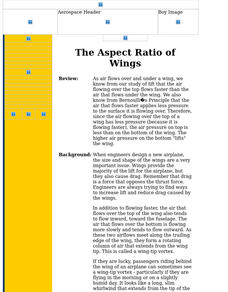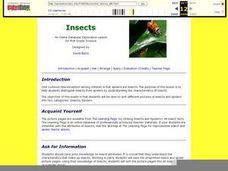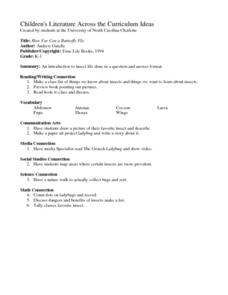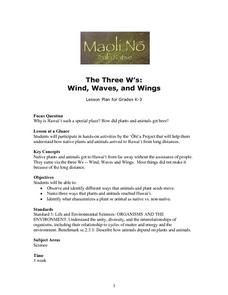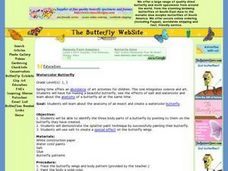Teach Engineering
May the Force Be With You: Lift
Get the class up and going with a lesson that discusses how airplane wings provide lift. Pupils use their knowledge of Bernoulli's Principle to develop an explanation of how it creates lift on airplane wings.
Teach Engineering
Windy Tunnel
Lift—it is about the wing's attack. Using a virtual wind tunnel, pupils investigate wing shape and angle of attack. Learners use worksheets to record their observations and to convert verbal relationships into mathematical equations in...
Teach Engineering
Airplane Tails and Wings: Are You in Control?
Keep everything under control. The lesson, the 16th segment in a 22-part unit, provides a more detailed look at the parts of a plane, specifically the control surfaces. Pupils learn about the construction of the wings and the tails and...
Teach Engineering
May the Force Be With You: Drag
Do not let friction drag you down! The 11th segment in a series of 22 focuses on the fourth force acting upon an airplane—drag. Pupils learn about the effects and causes of drag.
Cornell University
Insect Anatomy
Young entomologists discover insect anatomy in a very detailed unit plan. Offering background information for teachers about various insects, class members explore the differences between bugs and insects—and yes, there are many...
Curated OER
Crash Course in Flight
High school physicists demonstrate Bernoulli's Principle by blowing on different items and finding that they do not move in the expected direction! They apply Bernoulli's equation to the flight of an airplane. This well-organized lesson...
DiscoverE
Hoop Glider
Fly into an engineering lesson sure to get your scholars' interest off the ground. Young pupils create hoop gliders out of straws and paper hoops. Adjusting the size and number of the hoops lets them investigate the effect on flight...
Curated OER
The Art of Flying: Insects
Learners study insects. They examine how insect wings operate and make a model airplane that mimics the way insect wings operate as the insect is flying. They compare and contrast different kinds of insect wings and color a page of...
Curated OER
The Aspect Ratio of Wings
Junior engineers examine aspect ration in airplane wings. Using the length and width of two differetn wings, they calculate the aspect ratios and compare drag rankings. An engineering or space science class would benefit from this...
Curated OER
Science: How to Identify Insects
First graders discover how to distinguish spiders from insects by understanding the characteristics of each. They sort online picture pages into the two groups and examine the insects for common attributes. Students complete a worksheet...
Curated OER
The Kite
Historical facts and some diagrams about the structure of a kite are given in this PowerPoint. Interesting facts lead to the goal of individuals or groups designing and building their own kite. With this in mind, it might be useful to...
Curated OER
Proportions in Flight
Sixth graders explore physics by utilizing their math skills. In this flight properties instructional activity, 6th graders examine the flying capabilities of planes and birds. Students utilize math to find how many wing-beats are needed...
Curated OER
Minibeasts and Reading Strategies
Fourth graders explore reading strategies through roleplaying. In this reading lesson, 4th graders read Wings, Stings, and Wiggly Things by Martin Jenkins. Student groups pretend to be a law firm and identify words as their evidence to...
Curated OER
Airplanes
Students practice multiplication using factors to 5. They discuss the wings of birds and the wings of airplanes and complete activity sheet. Afterwards, they number and draw groups of airplanes.
Curated OER
Friendly Dragon-Flies
Learners listen to a story about, and visualize, fanciful dragons with wings. They create imaginative paper dragons that can fly. Students write fictional stories about the adventures of their flying dragons. They imagine if dragons...
Curated OER
How Far Can a Butterfly Fly
Students draw a picture of their favorite insect and describe. Students make a paper art project ladybug and write a story about it. Students map areas where certain insects are more prevalent. Students count dots on ladybugs and record.
Curated OER
Reptiles and Birds
In this reptile and bird worksheet, students will read a paragraph about reptile characteristics and then answer 2 short answer questions. Then students will read a paragraph about bird characteristics and complete 2 short answer questions.
Curated OER
Identifying Organisms
In this organisms activity, 9th graders look at each picture of insects and use the key at the bottom of the sheet to determine which order they belong to. Then they explain which insect is a true bug and which is a true beetle and...
Curated OER
The Three W's: Wind, Waves, and Wings
Students participate in hands-on acticities to understand how native plants and animals arrived on Hawaii from long distances without the assistance of man. They then identify what characterizes a plant or animal as native vs. non-native.
Curated OER
Whose Parts Do I Have? (Wings and Things)
Pupils identify an animal and a body part and then matches a body part to a specific animal. This will assess their ability to sort organisms and objects into groups according to their parts and describe how the groups are formed and...
Curated OER
The "Wright" Puzzle
In this airplane worksheet, students complete a crossword puzzle by figuring out the answers to 12 questions about the flying machines created by the Wright Brothers.
Curated OER
Adopt-An-Insect
In this biology instructional activity, learners locate examples of various types of insects listed in the chart and receive a point value for each according to its significance. Then they identify body parts and habitat for each item.
Curated OER
Butterfly Lesson
Students identify that Idaho is a home to 168 species of butterflies and they are an important part of many habitats. They also identify how to use the Digital Atlas of Idaho and write a report regarding information of their assigned...
Curated OER
Watercolor Butterfly
Students identify and analyze the anatomy of an insect and create a watercolor butterfly. They identify the three body parts of a butterfly by pointing to them on the butterfly they have created and demonstrate the splatter paint...










